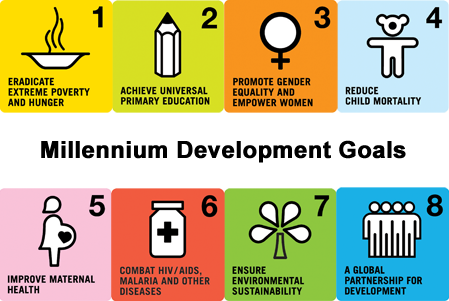The Millennium Development Goals (MDGs) were a set of eight international development goals adopted following the United Nations Millennium Summit in 2000. By 2015, these goals aimed to address important global concerns such as poverty, education, gender equality, child mortality, maternal health, disease, environmental sustainability, and global partnership. The MDGs, which were agreed upon by 189 countries, signified a global commitment to improving the lives of millions of people worldwide.
Table of Contents
What Are the Millennium Development Goals?

- Eradicate Extreme Poverty and Hunger: This target aims to reduce by half the number of individuals living on less than $1 per day
- Achieve Universal Primary Education: Ensure that all children, regardless of gender or socioeconomic position, receive a full primary education.
- Promote Gender Equality and Empower Women: Aim to eliminate gender disparities in education and empower women to take equal roles in society.
- Reduce Child Mortality: Aiming to reduce under-five mortality by two-thirds.
- Improve Maternal Health: Aiming to reduce maternal mortality by 75% and provide universal access to reproductive health.
- Combat HIV/AIDS, Malaria, and other diseases: halting and reversing their spread and providing universal access to treatment.
- Ensure environmental sustainability: incorporating sustainable development concepts into policy, preventing biodiversity loss, and enhancing access to safe drinking water and sanitation.
- Develop a Global Partnership for Development: to promote cooperation between developed and poor countries through aid, commerce, and technology transfer
Background and Formation of MDGs
The late 20th century saw the emergence of a more comprehensive framework for worldwide development, which served as the foundation for the MDGs. The Millennium Summit, held in September 2000, was a watershed moment when world leaders came together to approve the United Nations Millennium Declaration. This declaration laid out a vision for a world in which economic, social, and environmental inequalities are addressed collectively.
Consultations with governments, civil society, and international organizations helped define the Millennium Development Goals. Their simplicity and measurability distinguish them from prior global programs, allowing for better progress tracking and resource mobilization.
Achievements of the MDGs
By the 2015 deadline, the MDGs had made notable progress in several areas:
- Poverty Reduction: In 2015, 836 million people lived in extreme poverty, down from 1.9 billion in 1990.
- Primary Education: Global primary school enrollment rates have increased dramatically, with several countries obtaining nearly universal access.
- Gender Equality: Significant progress has been made in reducing the gender gap in education and expanding women’s presence in politics and the economy.
- Child Mortality: The under-five mortality rate decreased by more than 50%, from 90 to 43 deaths per 1,000 live births.
- Maternal Health: Maternal mortality rates have decreased by 45% globally.
- Disease Control: Reduced new HIV infections by 40% and malaria fatalities by 58%.
- Environmental Sustainability: Over 2.6 billion people now have access to better drinking water sources.
- Global Partnership: Developed countries’ official development assistance rose, and developing countries’ access to technology expanded.
Challenges and Criticisms of the MDGs
While the MDGs achieved significant milestones, they also faced several challenges:
1. Uneven Progress: Not all regions or countries saw equal benefits. Sub-Saharan Africa, for example, fell behind on numerous goals.
2. Lack of Inclusivity: Critics said that the MDGs neglected marginalized populations such as Indigenous communities and those with disabilities.
3. Overemphasis on Quantitative Targets: Prioritizing numerical goals might lead to neglecting qualitative aspects, such as education or healthcare.
4. Funding Gaps: Developing nations faced limited financial resources to implement MDG-related projects.
5. Global Inequalities: Structural challenges in trade, finance, and governance have slowed progress in certain regions.
Transition to Sustainable Development Goals (SDGs)
The MDGs paved the way for the Sustainable Development Goals (SDGs), which were approved in 2015 as part of the 2030 Agenda for Sustainable Development. The SDGs built on the MDGs by adding 17 goals and 169 objectives to address challenges like inequality, climate change, and peacebuilding.
In contrast to the MDGs, the SDGs represent a more inclusive and comprehensive approach to development and are generally applicable to all nations. They stress collaboration, innovation, and the pledge to “leave no one behind.”
The Legacy of the MDGs
MDGs mark a watershed moment in the global struggle against poverty and inequality. They exhibited the power of collaboration and sparked a new wave of development projects. The MDGs impacted global development discourse and practice by emphasizing both the opportunities and limitations of goal-oriented methods.
As we work to achieve the SDGs, the MDGs teach us the value of ambition, collaboration, and a shared vision for a brighter future.
Conclusion
The Millennium Development Goals (MDGs) were an ambitious and revolutionary agenda that accelerated progress in key areas of human development. While they did not meet all of their objectives, the MDGs unquestionably enhanced the lives of millions and laid the groundwork for future global development initiatives.
The transition to the SDGs represents a new chapter in this journey, building on the positives while addressing the shortcomings of the MDGs. By working together, the global community can continue to strive for a world in which no one is left behind.
FAQs
How Many Goals Are There In MDGs?
There are 8 goals in the Millennium Development Goals.
What Are MDGs?
The Millennium Development Goals (MDGs) addressed important global concerns such as poverty, education, gender equality, child mortality, maternal health, disease, environmental sustainability, and global partnership.